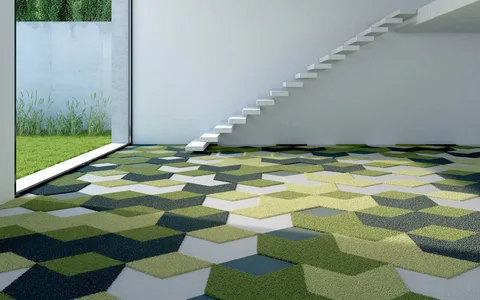Carpet tiles, also known as modular carpet, are a versatile and practical flooring option that has made a significant impact on interior design. These small, individual carpet squares have a fascinating history and have evolved from simple. Hence utilitarian floor coverings to stylish design elements. In this article, we’ll explore the rich history and evolution of them in interior design.
The Early Beginnings of Carpet Tiles
They have their origins in the late 1950s, but the concept of using modular carpet pieces dates back even further. Early iterations were made from scrap materials and were primarily used in industrial and commercial spaces. Their primary function was to provide a more cost-effective, durable, and easy-to-maintain alternative to traditional broadloom carpet.
1950s: Birth of the Carpet Tile Industry
The 1950s marked the birth of this industry as we know it today. The first modular carpet tiles were introduced by several companies, including Heuga and Interface. These early carpet tiles were basic, often plain, and mainly used in commercial settings.
1970s: Expansion into the Residential Market
During the 1970s, the popularity of them can be expanded into the residential market. Homeowners recognized the practicality of carpet tiles, as they allowed for easier installation, maintenance, and replacement of damaged sections. Therefore versatility of them was also gaining recognition.
1980s: Design and Aesthetics
The 1980s brought a shift towards more creative and design-focused carpet tiles. Companies began experimenting with colors, patterns, and textures, giving consumers the opportunity to be more expressive in their interior designs. This marked a significant turning point in the history of them, as they started to be seen as both functional and stylish.
1990s: Sustainable Innovation
As environmental concerns grew, so did the push for sustainable and eco-friendly products. Their manufacturers began to explore new materials and production processes that reduced waste and promoted recyclability. This era marked the start of sustainable practices in this industry, a trend that has continued to this day.
2000s: Technological Advancements
The 21st century brought significant technological advancements to the carpet tile industry. Computer-aided design (CAD) and cutting-edge manufacturing techniques enabled more precise and intricate patterns. Therefore making it possible to create stunning, customized carpet tile designs.
Today: A Flourishing Design Element
In the present day, best sisal carpet have come a long way from their humble beginnings. They have become a flourishing design element in both commercial and residential spaces. Today’s carpet tiles are available in a vast array of colors, textures, patterns, and sizes, allowing for endless design possibilities.
Advantages of Carpet Tiles in Interior Design
The evolution of carpet tiles has been driven by their numerous advantages in interior design. Here are some of the key benefits:
Versatility: Carpet tiles offer unmatched versatility, as they can be used to create various patterns, from classic to contemporary. Hence they can be easily customized to suit any space.
Easy Maintenance: Cleaning and maintenance are straightforward, as individual tiles can be replaced if they become stained or damaged. This makes carpet tiles an ideal choice for high-traffic areas.
Installation Ease: The installation of carpet tiles is simpler than traditional broadloom carpet. They can be installed in a variety of layouts, such as herringbone, brick, or monolithic, depending on the desired aesthetic.
Sustainability: Many carpet tiles manufacturers prioritize sustainable practices. Some tiles are made from recycled materials, and they are designed with easy recyclability in mind, reducing their environmental impact.
Acoustic Benefits: Carpet tiles can improve acoustic properties in a room by reducing sound transmission and echoing. Therefore making them a popular choice for commercial spaces.
Customization: Modern technology allows for nearly limitless customization options, enabling designers and homeowners to create unique, personalized spaces.
Applications of Carpet Tiles in Interior Design
Carpet tiles have found a place in a wide range of interior design applications, including:
Residential Spaces: In homes, carpet tiles are often used in bedrooms, living rooms, and playrooms. They allow homeowners to experiment with different patterns and colors to create unique and comfortable living spaces.
Commercial Spaces: The commercial sector has embraced carpet tiles due to their durability and ease of maintenance. Therefore offices, retail spaces, hotels, and educational institutions frequently use them. To enhance the design and functionality of their environments.
Hospitality Industry: The hospitality industry utilizes carpet tiles to create inviting and stylish interiors in hotels, restaurants, and other venues. Their easy-to-replace nature is especially valuable in high-traffic areas.
Healthcare Settings: In healthcare facilities, carpet tiles are often used to create a more comfortable and soothing atmosphere for patients and visitors. They can also help with noise reduction in busy hospitals.
Educational Environments: Schools and universities use carpet tiles to create vibrant and stimulating learning environments. They are also chosen for their durability and the ease with which they can be replaced if damaged.
Creative Spaces: Designers often use carpet tiles in creative and collaborative spaces. The ability to create unique patterns and designs adds an artistic element to these environments.
Sustainable Practices in the Carpet Tile Industry
One of the most significant trends in the evolution of them are the industry’s commitment to sustainability. Manufacturers are making strides in reducing their environmental impact through various practices:
Recycled Materials: Many of these are made from recycled materials, including post-consumer and post-industrial content. This reduces the need for new resources and minimizes waste.
Low VOC Emissions: Volatile organic compound (VOC) emissions can contribute to indoor air pollution. Sustainable carpet tile manufacturers prioritize low or zero VOC emissions, improving indoor air quality.
Recyclability: Manufacturers design them with recyclability in mind. When it’s time to replace them, the tiles can be recycled, reducing the burden on landfills.
Closed-Loop Manufacturing: Some companies have implemented closed-loop manufacturing processes, where waste materials from one part of the production cycle are repurposed in other stages, minimizing waste.
Carbon Footprint Reduction: Efforts are made to reduce the carbon footprint of manufacturing processes through energy-efficient practices and sourcing materials locally.
Certifications: Many sustainable carpet tile products carry certifications such as Cradle to Cradle, Green Label Plus, and LEED (Leadership in Energy and Environmental Design). Hence indicating their eco-friendly attributes.
Design Trends and Innovations in Carpet Tiles
In recent years, several design trends and innovations have emerged in the world of carpet tiles:
Biophilic Design: The integration of nature into interior spaces has gained popularity. They often feature natural patterns and earthy colors. Therefore promoting a sense of well-being and connection to the environment.
Mixing Textures: Designers are increasingly mixing different carpet tile textures in a single space to create visual interest and delineate different areas.
Sustainability as a Design Element: Sustainability is not only a manufacturing practice but also a design element. Many designers showcase eco-friendly materials as part of the overall design concept.
Geometric Patterns: Geometric patterns, such as hexagons and chevrons. Hence they have become popular choices for creating eye-catching designs with them.


